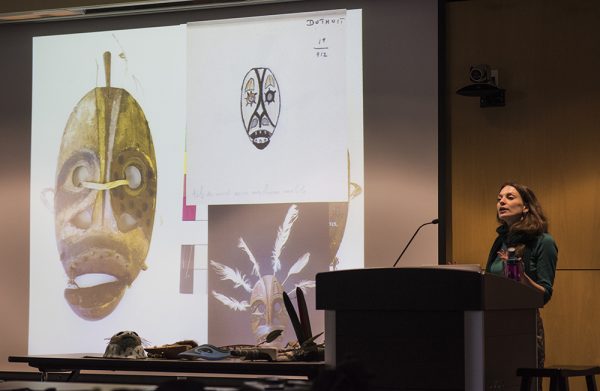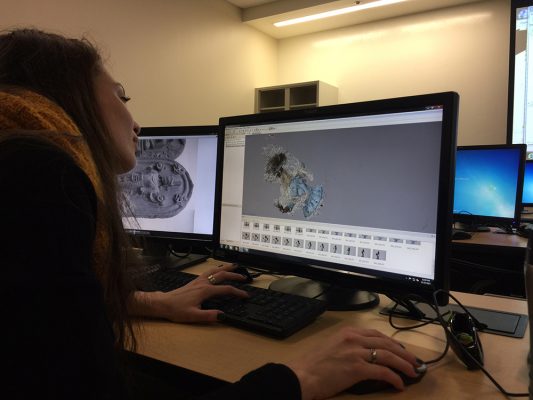Estonian Fulbright winner talks about UAA and her exploration of mask-making
by Tracy Kalytiak |

Estonian Fulbright scholar Anna Mossolova talks about her research into Alaska Native mask making, at an event organized by the UAA Campus Bookstore in December. (Photo by Sven Haakanson)
Anna Mossolova earned her B.A. and M.A. degrees in semiotics and culture studies from the University of Tartu, Estonia. After graduating from her "relatively theoretical" master's program, she decided to change her disciplinary approach and methods. "I wanted to focus more on the material culture of the past and its interpretations and meanings for people nowadays," she said. So, in 2013, Mossolova started her Ph.D. in cultural anthropology to study the past and present of mask making in Southwest Alaska. Here, she talks about the Fulbright program that brought her to Alaska, her fascination with Alaska Native culture and the technology she learned at UAA that will help her in the future.
How did you first become interested in Alaska Native cultures and masks? Masks have always been my passion! From the very first undergraduate year I have been researching mask-making and masking traditions across the globe, but especially in the North (I grew up in a Nordic culture). Before coming to Alaska, I had a chance to conduct my research and work with Alaska Native collections, Yup'ik mask collections in particular, in several museums in Europe and Russia; those experiences completely cemented my desire to go to Alaska and learn more about Alaska Native cultures.
First time I came to Alaska in the summer of 2015 to dig at the Nunalleq site in Quinhagak. Being part of Dr. Rick Knecht's crew, rescuing hundreds of almost intact 500-year-old Yup'ik artifacts from erosion, and seeing the importance of such a project for the local community was another transformative experience for me.
What led to you applying for and receiving the Fulbright? What was it like when you heard you received the Fulbright, and what was the Fulbright goal for you? My goal was to get close to a number of field sites in order to conduct research at the museums and do fieldwork in the communities. The Fulbright seemed to have a perfect program for that-Fulbright Foreign Student Program for students and young professionals from abroad interested in research or studies in the United States. I applied for a Fulbright grant in summer 2014, and, in my case, it took almost a year to receive and confirm it. I knew it would be a life-changing experience and that the waiting was worth it. Never lost my hope and was extremely happy to be accepted at UAA. I also very much appreciated the opportunity to be hosted here by both the Department of Anthropology and the Alaska Native Studies Program. This allowed me to build diverse academic and personal connections as well as community relations.
When did you arrive? I arrived in late October 2015, and stayed for 10 months.
Where did you go and what did you do while here? I was working in Quinhagak, Bethel, and Anchorage, recording audio and video interviews with Native artists and culture bearers about traditional and contemporary masks and mask making. I have seen masks being made and danced-an unforgettable experience! I was also lucky to see and study most of the ethnographic (19th and 20th century) Yup'ik mask collections housed in Alaska. I visited the Museum of the North in Fairbanks, Anchorage Museum, Sheldon Jackson Museum in Sitka, and had the honor and pleasure to work with Eva Malvich, curator of the Yupiit Piciryarait Museum in Bethel. Moreover, I have examined the collection of the Burke Museum in Seattle and the Art Museum in Denver.

Anna Mossolova, an Estonian predoctoral Fulbright scholar, takes part in a 3D-imaging workshop, part of a collaboration between the UAA anthropology and engineering departments. (Photo by Tracy Kalytiak / University of Alaska Anchorage)
Another thing I learned here, and that-to be honest-wasn't on my agenda initially, was three-dimensional modeling. Back in December, my UAA faculty advisor Dr. Medeia Csoba DeHass kindly invited me to attend an intensive course on 3D modeling of archaeological and ethnographic artifacts taught by Dr. Gennady Gienko. Working with these new technologies was fun but also challenging! The fascinating world of three-dimensional technologies opens new possibilities for museums, researchers and communities to share knowledge and get virtual access to the collections from all over the world. I have been working on creating 3D models of Yup'ik masks from the museum collections in Bethel and Fairbanks, and I will be exploring and using 3D in my further research in Europe, for sure.
What were the most rewarding experiences you had in Alaska? I think one of the most rewarding experiences for me in Alaska was working with contemporary mask makers: talking to them, observing how masks are being made, and what carving techniques and tools are being used, etc. The making process is absolutely thrilling! With Drew Michael, a Yup'ik mask maker who is doing traditional art form in a contemporary fashion, we've even created a 16-minute video showing the entire process of mask making: from choosing and shaping a block of wood to shipping the finished piece to France for an art exhibit. In this video, Drew talks about the role of mask carving in forming his cultural and personal identities, and addresses other important questions, e.g. why it is important for an artist to learn from and work closely with the communities.
Driven by curiosity to explore the process of mask making from inside, I started carving myself. Under the guidance of two incredible Alaska Native artists, Alvin Amason and Perry Eaton, I made my first mask, which is in fact a replica of one of the Yupiit Piciryarait Museum's masks. Both Alvin and Perry are amazing teachers: all that knowledge, all the tips and tricks, and encouragements they shared with me were invaluable.
What do you hope to do with what you learned here? I have one year of my Ph.D. program left, and I intend to spend it writing my dissertation. I am planning to come back to Alaska next summer to continue working in Quinhagak and Bethel. Southwest Alaska is undoubtedly a very special place that makes you feel desperate to come back! Last but not least, I will definitely continue carving!
 "Estonian Fulbright winner talks about UAA and her exploration of mask-making" is licensed under a Creative Commons Attribution-NonCommercial 4.0 International License.
"Estonian Fulbright winner talks about UAA and her exploration of mask-making" is licensed under a Creative Commons Attribution-NonCommercial 4.0 International License.














